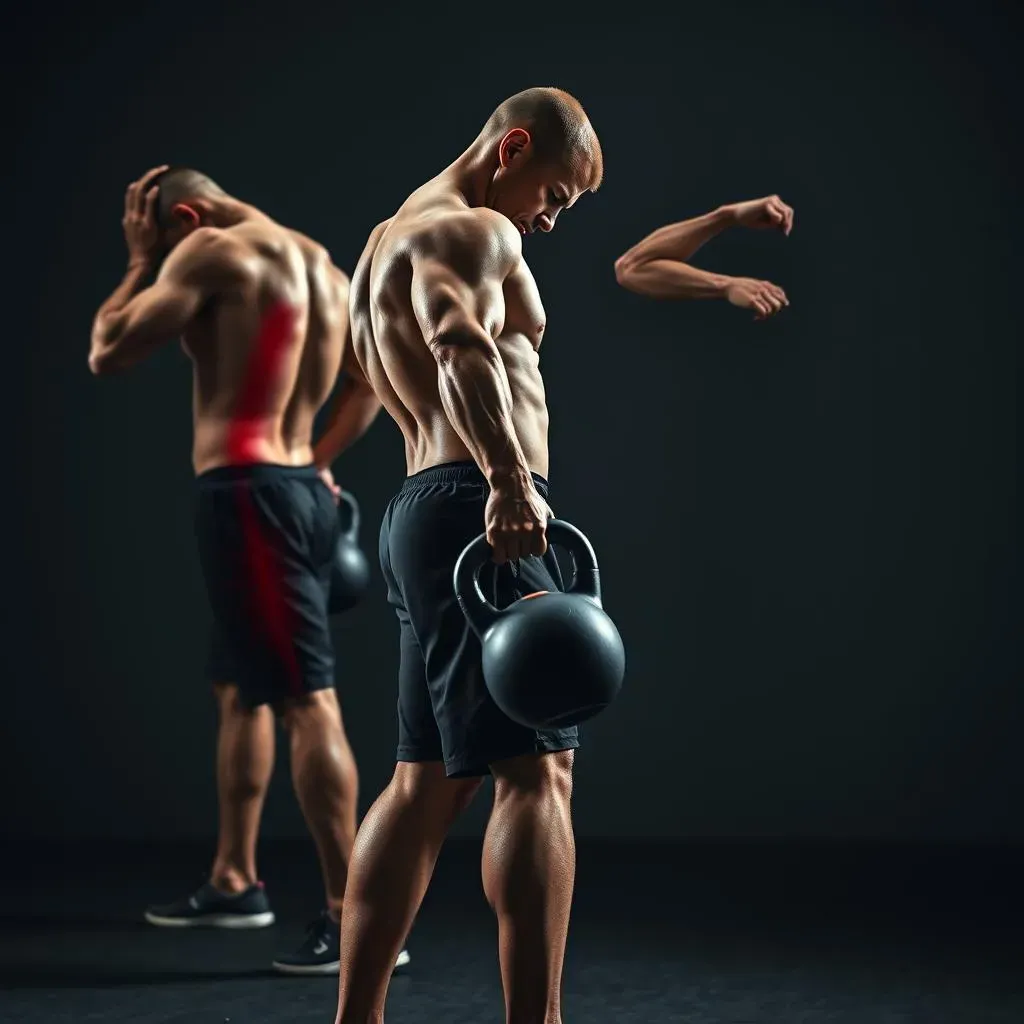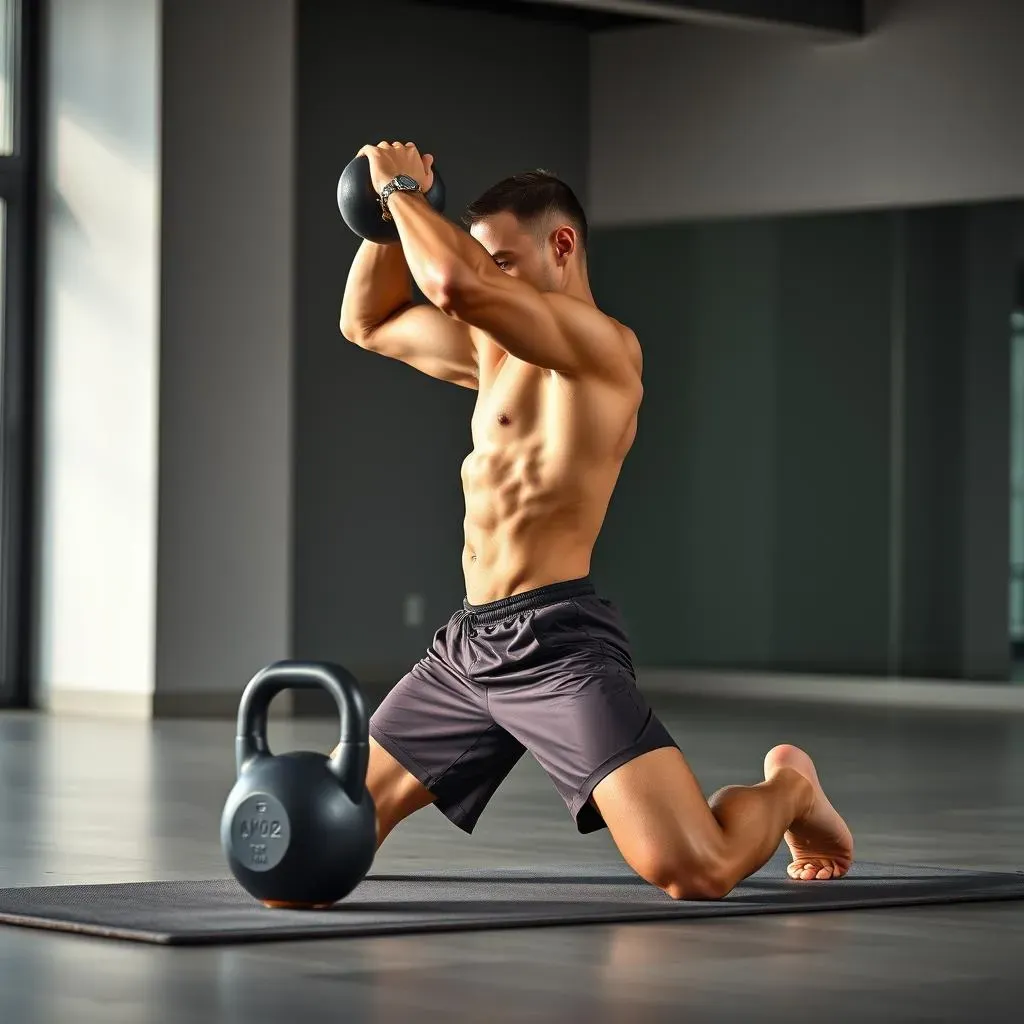Table of Contents
Ready to carve a bulletproof core and unlock a new dimension of rotational power? The kettlebell core around the world exercise might just be your new secret weapon. This dynamic movement isn't just about swinging a weight; it's a full-body engagement that challenges your stability, strengthens your midsection, and improves your coordination. Forget endless crunches – we're diving into a functional exercise that translates directly to real-world strength and athleticism.
Mastering the Kettlebell Around the World: Technique and Form

Mastering the Kettlebell Around the World: Technique and Form
The Foundation: Setting Up for Success
Alright, let's nail the foundation. Start with your feet about shoulder-width apart, just like you're gearing up for a squat. Grip the kettlebell with one hand, keeping your arm straight but not locked. Think of it like a pendulum ready to swing. Your core should be engaged from the get-go – that means bracing your abs as if you're about to take a punch. Posture is key here; stand tall, chest proud, and shoulders back. This isn't just about looking good; it's about protecting your spine and maximizing the exercise's effectiveness.
Now, before you even think about moving the kettlebell, take a deep breath and ground yourself. Feel your feet connecting with the floor. This exercise is about control and precision, not speed or momentum. Rushing into it is a recipe for sloppy form and potential injury. Remember, we're building strength and stability, one rep at a time.
The Movement: Smooth and Controlled Rotation
here's where the "around the world" magic happens. Start by gently passing the kettlebell around your torso, keeping your arm extended. The movement should be smooth and controlled, not jerky or rushed. Imagine you're tracing a circle around your body with the kettlebell. As you pass the kettlebell from one hand to the other, maintain that core engagement. Don't let your torso twist excessively; the movement should primarily come from your arms and shoulders.
A common mistake is letting the kettlebell drift too far away from your body. Keep it close, almost grazing your torso as it moves around. This helps maintain control and prevents unnecessary strain on your shoulders. Also, be mindful of your breathing. Exhale as you pass the kettlebell from one hand to the other, and inhale as it comes back around. This rhythmic breathing will help you stay relaxed and focused throughout the exercise.
Key Element | Description | Why It Matters |
|---|---|---|
Stance | Shoulder-width apart, grounded | Provides stability and balance |
Grip | One hand, straight arm | Allows for controlled movement |
Core Engagement | Braced abs | Protects spine and enhances stability |
Movement | Smooth, controlled rotation | Maximizes effectiveness and minimizes risk of injury |
Unlocking Kettlebell Core Strength: Benefits of Around the World

Unlocking Kettlebell Core Strength: Benefits of Around the World
Fortifying Your Midsection: Core Stability and Strength
Let's talk core. The kettlebell around the world isn't just a fun party trick; it's a serious core strengthener. Unlike static exercises like planks, this movement challenges your core in a dynamic, rotational way. This means you're not just building strength; you're building stability and control through a full range of motion. Think about it: your core is constantly working to stabilize your spine as you pass the kettlebell around your body. That's real-world strength that translates to everything from lifting groceries to crushing your next workout.
And it's not just your abs that are getting a workout. The kettlebell around the world engages your obliques, lower back, and even your hips. This comprehensive core engagement leads to improved posture, reduced risk of injury, and increased overall athleticism. Plus, who doesn't want a stronger, more defined midsection? It's a win-win situation.
Beyond the Abs: Full-Body Integration
While the core takes center stage, the kettlebell around the world is far from a one-muscle show. Your shoulders are working hard to control the kettlebell's movement, building strength and stability in the process. Your grip strength is also being tested, as you need to maintain a firm hold on the kettlebell throughout the exercise. And let's not forget about your legs; they're providing the foundation for the entire movement, engaging your quads, hamstrings, and glutes to keep you stable and balanced.
This full-body integration is what makes the kettlebell around the world such a valuable exercise. It's not just about isolating individual muscles; it's about training your body to work as a cohesive unit. This is how you build functional strength that translates to improved performance in all aspects of your life.
Improved Mobility and Coordination: The Unsung Heroes
Beyond strength, the kettlebell around the world offers some surprising benefits. The controlled rotational movement can improve your shoulder mobility, helping to alleviate stiffness and improve your range of motion. This is especially beneficial for those who spend a lot of time sitting at a desk or performing repetitive movements.
Furthermore, this exercise challenges your coordination and proprioception (your body's awareness of its position in space). As you pass the kettlebell around your body, you're constantly adjusting your movements to maintain balance and control. This improved coordination can translate to better performance in sports and other physical activities, as well as reduced risk of falls and injuries. So, it's not just about looking good; it's about moving better and feeling more confident in your body.
Avoiding Pitfalls: Common Mistakes in Kettlebell Around the World

Avoiding Pitfalls: Common Mistakes in Kettlebell Around the World
Rounding the Back: The Posture Peril
Alright, let's get real about mistakes. One of the biggest culprits in the kettlebell around the world is rounding the back. This happens when you lose core engagement and let your shoulders slump forward. Not only does it look bad, but it puts your spine at serious risk of injury. Think about it: you're adding weight and rotational movement to a compromised position. That's a recipe for disaster. Instead, focus on maintaining a tall, proud chest and engaging your core throughout the entire exercise. Imagine you're wearing a corset that's pulling you up straight. This will help you maintain proper posture and protect your spine.
Another common mistake is bending the arms excessively. This turns the exercise into more of a bicep curl than a core strengthener. Keep your arms relatively straight, but not locked, throughout the movement. The rotation should come primarily from your shoulders and torso, not your arms. If you find yourself bending your arms to compensate, it's a sign that you're using too much weight. Scale it back and focus on maintaining proper form.
- Rounding the back: Maintain a tall, proud chest and engage your core.
- Bending the arms: Keep arms relatively straight and use a lighter weight if needed.
Using Momentum Over Muscle: Cheating Your Way to Nowhere
We've all been there – tempted to use momentum to get through a tough exercise. But when it comes to the kettlebell around the world, cheating is only cheating yourself. Relying on momentum instead of muscle engagement not only reduces the effectiveness of the exercise but also increases your risk of injury. The goal is to control the kettlebell's movement with your core and shoulders, not to swing it around wildly.
To avoid this pitfall, slow down the movement and focus on engaging your core muscles. Imagine you're moving in slow motion, deliberately controlling every inch of the kettlebell's path. If you find yourself struggling to maintain control, reduce the weight or shorten the range of motion. Remember, it's better to do fewer reps with proper form than to crank out a bunch of sloppy reps. Quality over quantity, always.
Mistake | Consequence | Solution |
|---|---|---|
Rounding the back | Spinal injury | Engage core, maintain tall posture |
Bending the arms | Reduced core engagement | Keep arms straight, use lighter weight |
Using momentum | Reduced effectiveness, injury risk | Slow down, focus on muscle engagement |
Ignoring Grip Strength: Losing Control of the Bell
Don't underestimate the importance of grip strength in the kettlebell around the world. A weak grip can lead to losing control of the kettlebell, which can be dangerous. If you find your grip fatiguing quickly, it's a sign that you need to work on strengthening your hands and forearms.
There are several ways to improve your grip strength. You can use grip strengtheners, do farmer's walks with heavy kettlebells, or simply practice holding onto a kettlebell for extended periods of time. Also, be mindful of your grip during the exercise itself. Avoid gripping the kettlebell too tightly, as this can lead to fatigue. Instead, focus on maintaining a firm but relaxed grip, and let your core and shoulders do the work.
Beyond the Basics: Kettlebell Core Around the World Variations and Programming

Beyond the Basics: Kettlebell Core Around the World Variations and Programming
Adding a Twist: Kettlebell Core Around the World Variations
so you've mastered the basic kettlebell core around the world. Now what? Time to spice things up with some variations! One of my favorites is the kettlebell halo. Instead of passing the kettlebell around your torso, you pass it around your head, keeping it close to your neck and shoulders. This variation really challenges your shoulder mobility and core stability. It's like the around the world's sophisticated cousin.
Another fun variation is the tall-kneeling kettlebell halo. This one takes away your base of support, forcing your core to work even harder to stabilize your spine. It's a humbling exercise, but it's incredibly effective for building core strength and improving balance. Plus, it looks pretty cool when you nail it. For an added challenge, try performing the around the world or halo with a heavier kettlebell, or increase the speed of the movement. Just remember to prioritize proper form over speed and weight.
- Kettlebell Halo: Pass the kettlebell around your head.
- Tall-Kneeling Kettlebell Halo: Perform the halo while kneeling.
- Heavier Kettlebell: Increase the weight for an added challenge.
- Increased Speed: Speed up the movement (with good form!).
Programming for Success: Integrating Kettlebell Core Around the World into Your Routine
So, how do you actually fit the kettlebell core around the world into your workout routine? Well, that depends on your goals. If you're using it as a warm-up, stick to lighter weights and higher reps (15-20 per side) to get your muscles moving and your joints lubricated. If you're using it as a strength exercise, go heavier and aim for lower reps (8-12 per side) with a focus on controlled movement. And if you're using it as an endurance exercise, try performing the movement for a set amount of time (30-60 seconds per side) with minimal rest.
Don't be afraid to experiment with different rep ranges, sets, and rest periods to find what works best for you. And remember to listen to your body. If you're feeling pain, stop and rest. The kettlebell core around the world is a fantastic exercise, but it's not worth injuring yourself over. Start slow, progress gradually, and enjoy the process of building a stronger, more resilient core.
Goal | Weight | Reps | Sets |
|---|---|---|---|
Warm-up | Light | 15-20 per side | 2-3 |
Strength | Heavy | 8-12 per side | 3-4 |
Endurance | Moderate | 30-60 seconds per side | 2-3 |
Wrapping Up: Kettlebell Core Around the World for a Stronger You
The kettlebell around the world is more than just a flashy exercise; it's a potent tool for building a resilient core, enhancing rotational power, and improving overall functional fitness. By mastering the proper technique, understanding its benefits, and incorporating it strategically into your workouts, you can unlock a new level of strength, stability, and athletic performance. So, keep practicing, stay consistent, and watch as the kettlebell around the world transforms your core and your entire body.